Late Period Warrior in Hakama and Kataginu
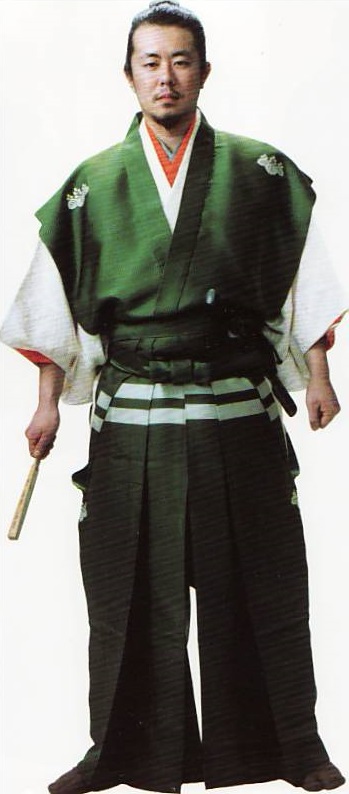
Outline |
|---|
|
Use layouts, fabric width, and your measurements to calculate yardage Buy fabric, thread, and supplies Viola! |

This is a photo from the costume museum. This outfit is probably silk hakama, kataginu, and white kosode, the outer most layer under the vest. The white silk has large medallion pattern woven into the fabric. The horizontal stripes were probably dyed. It isn't obvious what the under kosode are made of.
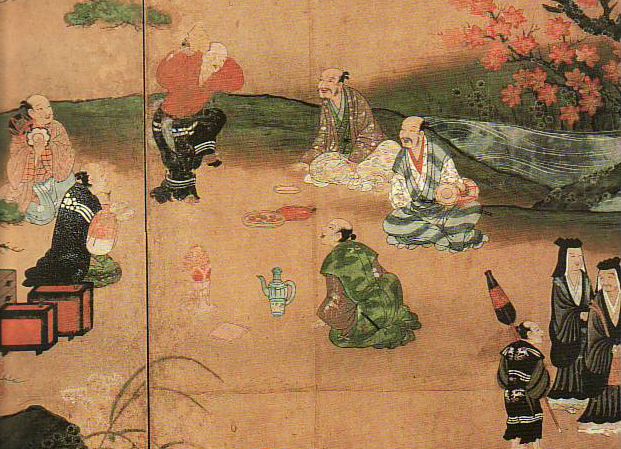
Here is a second picture, Maple Viewing on Mount Takao, of a screen that was painted late period. There are a few men wearing hakama and kataginu. It shows a wider variety of patterned fabric, so solid color or solid with two or three stripes isn't your only option.
The overall construction is there are vertical panels that are jointed along the long edge to make the outfit. The panels in period were between 14 and 18 inches wide. Fabric width back in period was variable, unlike now when the fabric is a much more uniform width of 14 inches. That means that both edges of the full-width panels were selvages so they wouldn't fray. Using modern sewing techniques you can create finished seam allowances in a number of ways: serge or zigzag the raw edges, use french seams, or turn the seams under a second time and tack them down.
Upper class warriors and nobility would wear silk. However, my fabric recommendations for this and most outfits are more practical than silk because at most events we are all working and encounter plenty of dirt, food, grease, sunscreen, etc. Ramie and Hemp were used in period. Cotton was introduced during the Muromachi period 1338-1477 and was used often, replacing hemp or ramie. I recommend linen, hemp, ramie, and cotton for the hakama and kataginu. I recommend a light weight linen or ramie as the bottom most kosode. Outer kosode can be ramie, linen, or cotton.
One important note, is that stripes in period Japanese fabrics were horizontal based on extant garments, costume museum pictures, and screens that depict the outfits. If you want horizontal stripes, you need to look carefully at any fabric to make sure the stripe is horizontal. You could try painting stripes to get that three strip effect. You could also try dyeing light fabric with clamped horizontally folded fabric to add stripes to the whole length of the panel, or just part of it.
You may want different fabrics for the different garments or layers. For example, bottom layer short kosode in lightweight white linen, outer short kosode in patterned cotton, hakama and kataginu in solid color medium weight linen. I have general recommendations for fabric, and have listed some online sites that I have used, but there are so many choices. When you find something you like and that has appropriate fiber content, make note of the fabric width so you can figure out how many yards or meters to order.
Online resources for fabric and some comments. This is very limited list, but a few web searches will likely turn up more options. I find that "ramie fabric by the yard" searches found some nice fabric on ebay and alibaba.
In all my layouts I am assuming that you want your hakama hemmed around ankle length because of wearing shoes, dirty floors, and walking around outside. In period, they removed their shoes at the door and the floors were covered and kept clean. They also sometimes used leg wraps or bands around the bottom hem to keep the fabric from dragging when outdoors. Use the layouts that I have put together for common widths to calculate yardage. Both 45" and 50" assume 7 yards, but you may be able to use only 6.5 yards if the fabric can be bought in 1/2 yard measurement. The 55" layout specifies 6.5 yards even though the layout only uses 6 yards total. I try to leave a little wiggle room in the width for shrinkage, and usually add at least 1/2 yard for shrinkage in the total length.
Use the individual piece measurements that I list to adjust your layout, especially for the leg panel length. For the hakama legs I am assuming that floor to waist measures 40". If you are taller than that or shorter than that make a note and make sure you cut your leg panels to that length. I am assuming that your waist is between 30 and 40 inches. So unless you are much larger around, you probably do not need to adjust your himo lengths. If there is extra width available, make your kataginu body panels and neckband wider. Hakama leg panels is good as well, but they are already over large.
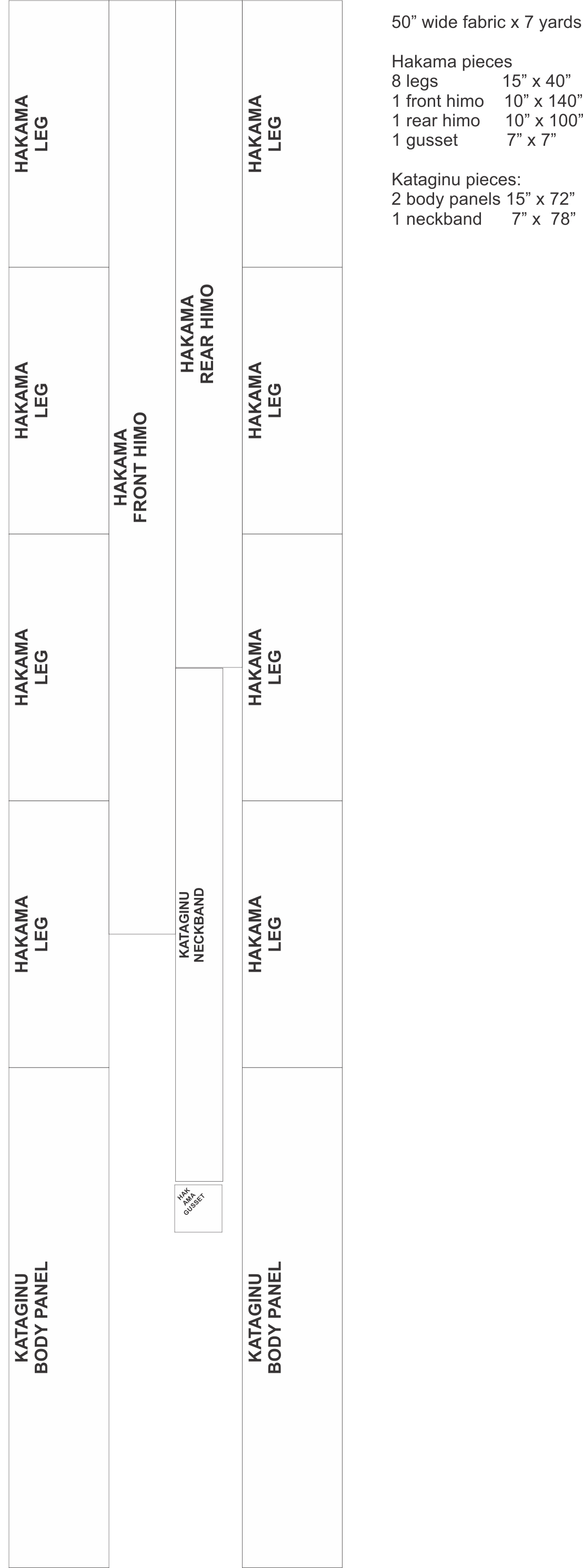
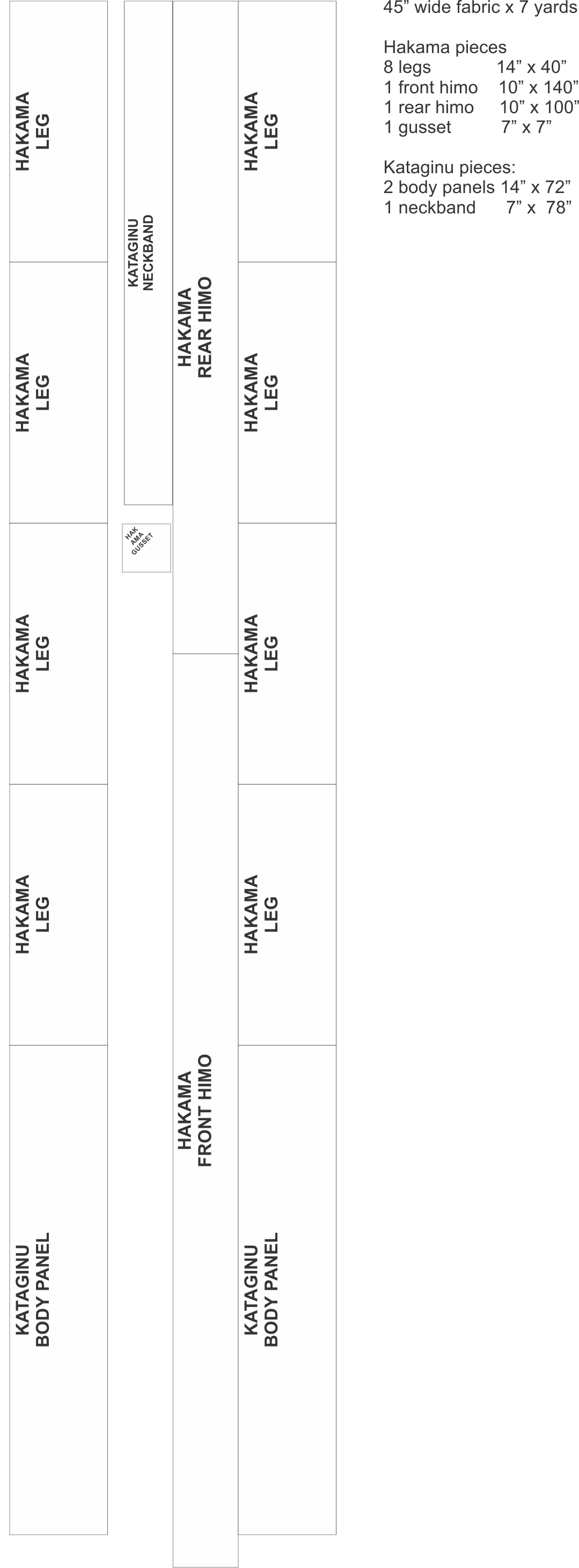
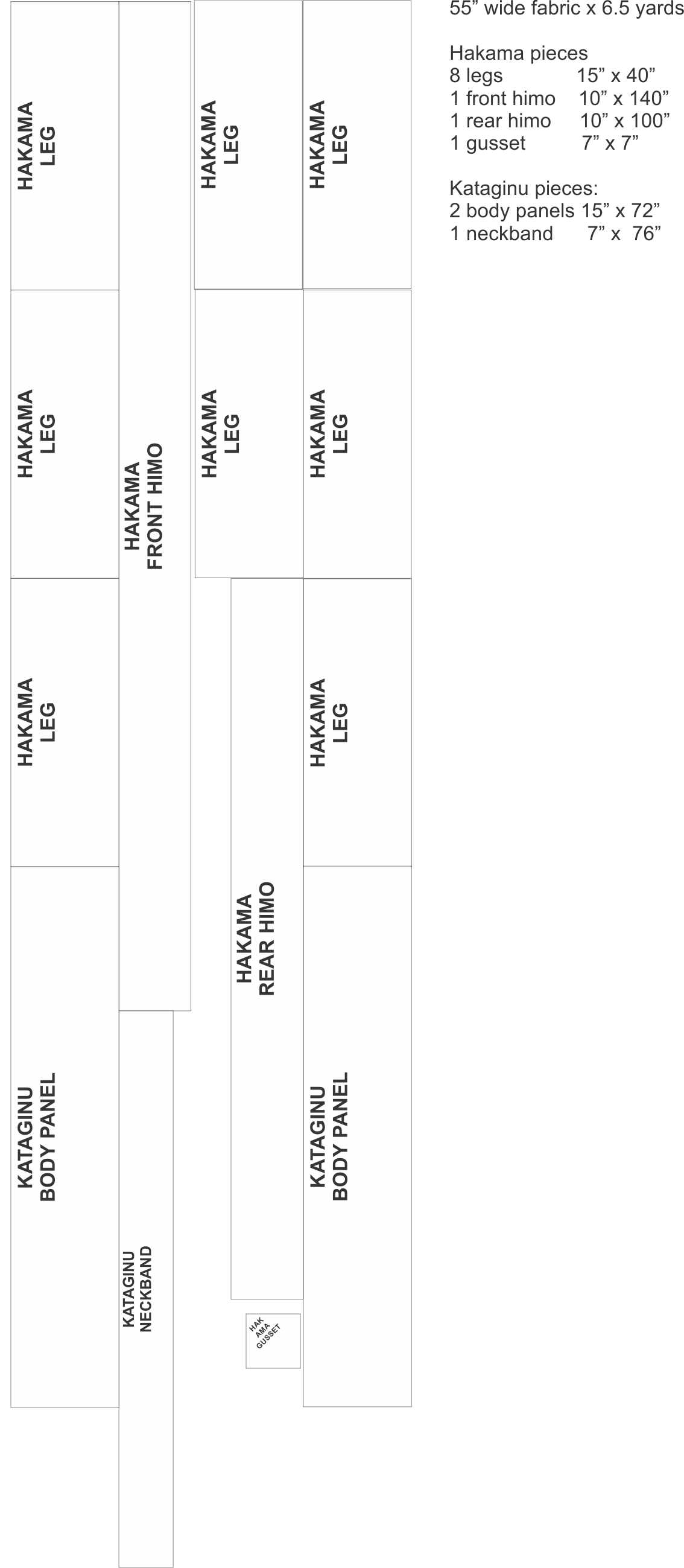
Order your fabric, thread, and other supplies. Don't forget matching thread for each color fabric you are using. I try to use cotton thread when sewing cotton, linen, ramie, or hemp fabric. You may need extra thread if you are finishing your edges by zig-zag, french seams, or turning seam allowances a second time and tacking. If you are serging the edges, don't forget your serging thread too. Make sure you have a way to mark your fabric, when you lay it out. I use the Mark B Gone markers.
Wash and dry: I would wash any white fabric, separately, in hot. I would also wash light solids separately in warm. Darks or brights I would wash in cold, separately by color. If you buy fabric with metallic thread in the weave or print, I recommend cool on delicate cycle.
Dry your fabric on normal settings, unless it is metallic, then use delicate setting.
Iron your fabric.
Refer to the appropriate layout and any adjusted leg panel lengths. Use yardstick and marker/chalk to mark pieces and cut. The panels should run along the grain of the fabric. Hakama ties, himo, I cut along the grain too even though that means when they are attached the grain is cross-ways to the long panels.
If you have access to a serger, I recommend that you finish the edges of the hakama leg panels and gusset and the kataginu body panels. The kataginu neck band and waist ties, himo, are have all edges folded inside, so finishing those edges isn't necessary unless you pick some fabric that frays very easily. You can also finish edges by sewing a zigzag stitch very near the edge.
General notes: I am assuming 3/4" seam allowance, to allow for you to turn the seam under and tack, but if you have finished edges, you can use a smaller seam allowance. If you want to use french seams, it should be pretty easy with all the straight seams, but at the gusset, I recommnd that you turn seam allowance under and tack. The topology at the gusset would make french seams difficult. In period, they start with a long bolt of fabric. Then they cut it into lengths. In period, the seams would be a very wide basting stick with stitches at least 1/2 inch apart. Also, any extra fabric is not cut away, but is folded into seam allowance. To clean a garment, you would take it apart, turn it back into a single bolt of fabric and clean it that way. Thus, some of the narrow pieces that I have you cut, may have not been cut narrow, but may have been folded or turned into wide seam allowance.
Sew each pair of leg panels together for the each front leg and back leg. This will give you four double-panels. You should try to keep selveges along the outer edges that will make the side seams.
Take two double-panels and sew them together length-wise between 1/3 and 1/2 of the length down. Do the same for the other two double-panels. How far down to sew is a personal preference. If you are a female wearing hakama, you may want the seam to go 1/2 way down, so that it is easier to fold the back panel out of the way when using the port-a-john or toilet.
You should fold the ties lengthwise in half and press. Then open them up and press each edge to the middle and press. Now fold them back up and press. You should have a long strip that is 4 layers thick with only folded edges along the length. Now open the folded tie and fold the ends in about 3/4 inch and press. See the picture showing edges pressed to center and the fully folded waistband.
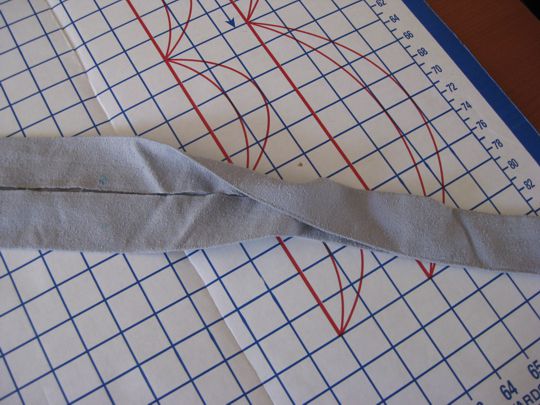
The sides aren't sewn all the way to the top. Instead the seam ends around the knee or a little higher, and the tops are folded diagonally towards the center. This makes a V at the top of each side. See the picture below showing the side V. The bottom of the V should always be above the bottom of your kosode, so there is no skin showing at the side. If your fabric has nice selvages and is the same color on both sides, you can fold the V out. If your fabric is printed so the inside isn't the same or if you need to finish the edges, fold the V towards the inside. In the picture below, the front V is folded out and the rear is folded in. The green panel you see on the side under the V is the bottom of the kataginu. Notice that it goes lower than the V opening.
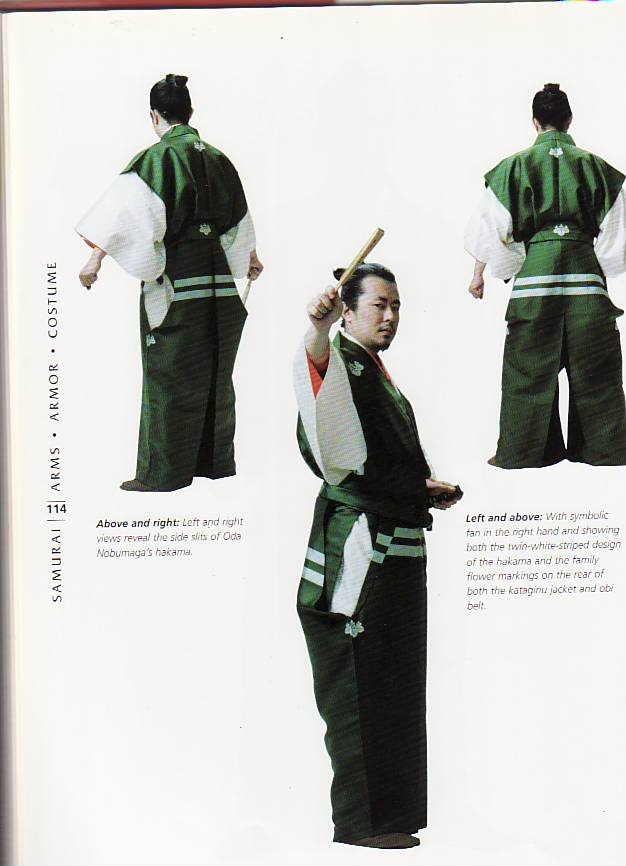
Measure from your waist down to around your knee or above the knee depending on preference and length of kosode. Now mark the side edges of both double front panels and double back panels at the side. Now at the top side of each double panel mark 3 or 4 inches in from the edge. Now fold the top sides of each panel outward (or inward) towards the center seam with the fold line running from the side mark to the top mark and pin. You may want to sew along the edge of the folded panel to keep it in place; however, the top will be sewn into the waist band and that should keep the fold in place.
The fronts of mens garments had pleats, there were at least two pleats per side, in addition to the V fold which makes a third pleat.
Calculate pleat width: Measure your waist. Now divide by two and subtract two inches. This is the desired length width or F. You are leaving at least an inch at each side opening. Now measure the current width. Measure the front of the hakama from edge to edge 2.5 inches from the top. RE: The top is sewn into the waistband which is 2 1/2 inches wide, so measure 2.5 inches from the top. Call that measurement S for starting front. Now subtract F from S and divide by 4 pleats to figure out how much to fold into each of the four pleats. For example: Let's say that the fabric is 50 inches across when measured 2.5 inches from the top. You want it to be 18 inches wide. 50-18 = 32 extra inches of fabric. There will be 4 pleats. So 32 / 4 = 8 inches in each pleat.
Measure, fold, and pin the front pleats: Lay the fabric with right side facing up. Measure out from the center seam on each front double panel and mark the pleat edge. Now pinch the fabric at that edge and fold over to the center so that the pleat edge lines up with the center on both sides and pin. Now decide where you want the outer pleat to sit. I like the inner edge of the outside pleat to match up with the outer fold of the inside pleat. Mark the line where you want the outer pleat to start. Measure, fold, and pin the outer pleats.
Mark, Pinch, and Fold First Dart (black line marks center seam) | ||||
|---|---|---|---|---|
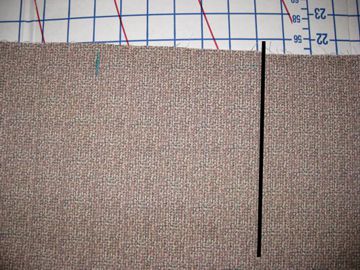
|
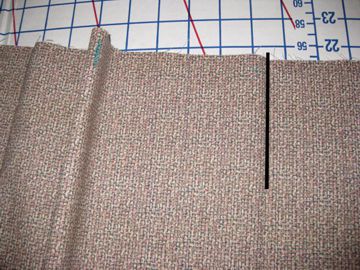
|
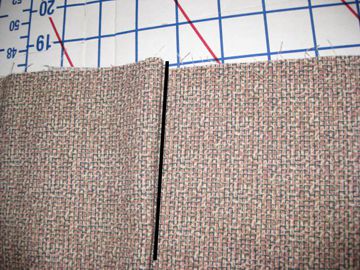
|
||
Mark, Pinch, and Fold Second Dart - See top of V | ||||
|---|---|---|---|---|
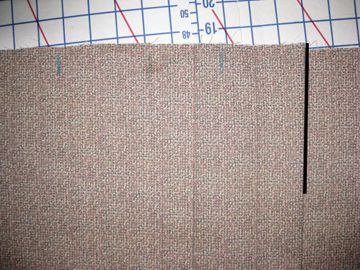
|
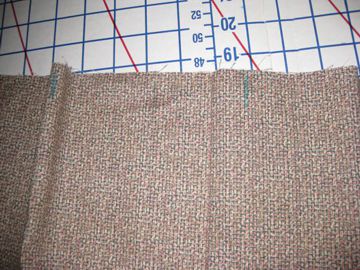
|
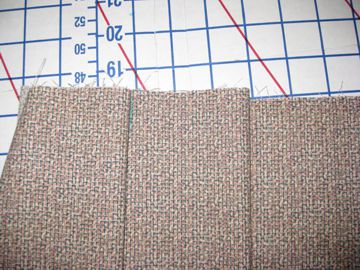
|
||
Staystitch the top edge: Pin where there is a fold or seam allowance so nothing catches wrong. Stitch the edge close to where it will attach to the waistband. The waistband is 2.5 inches wide, sew 2.25 inches from the top so the seam will be inside the waistband. This way the diagonal folds, the pleats, and the seam allowances are all tacked down. This makes is easier to attach the waistband.
You are following the same process that you used for the front pleats, except there are two pleats not four and staystitch the back pleats and diagonal folds.
Take the back waistband, or himo, and mark the center. Now unfold the himo. With right sides together line the center of the waistband with the center of the back and the edge of the himo just above the top edge of the back panels. Pin along the fold of the himo. You may want to make sure that you get the pleats and the diagonal fold to lie flat. You only need to pin and stitch from one edge of the back panel to the other edge. Stitch just above the fold rather than on the fold, so the fabric will still fold nicely. Do the same thing with the front himo and the front panels.
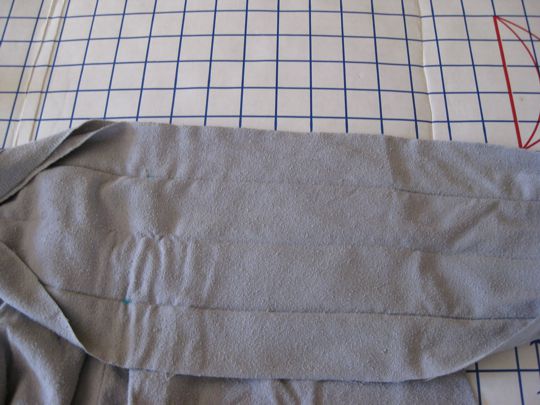
Refold the front hime lengthwise by folding over the top edge of the front panel and pin the ends that are not sewn to the leg panels. Starting at the end of each himo stitch end and then the side edge all the way the the leg panel, stitch 1/4" (or less) from the edge of the himo. Do this with both ends of the front and back himo. Now, you can machine stitch or slip stitch the inside edge of the waistband to the legs.
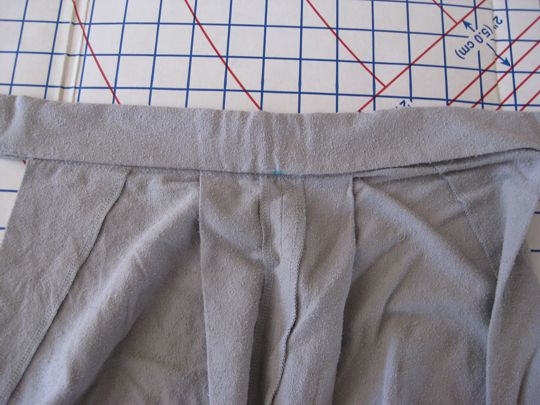
Fold gusset diagonally wrong sides together. Mark one corner of that diagonal as front and the other as back. Now place front gusset corner at the bottom corner of the front center seam with right sides facing each other. Make sure the edges of the pants line up with the edges of the gusset. Pin the gusset and stitch from the corner at notch along the edge of the gusset and stop 3/4" from the end. After you attach the two gusset edges to the two front leg panels, now attach the two remaining gusset edges to the back panels at the bottom of the center seam. Make sure you take care to put right sides together.
This picture shows the gusset in place. The top point of the gusset is attached at the bottom of the front center seam 3/4" in from the gusset corner to allow for seam allowance. The bottom point of the gusset is attached at the bottom of the back center seam 3/4" in from the gusset corner as well. Each gusset seam runs along a leg inner edge. The tops of the leg inseams start 3/4" in from the side points of the gusset and attach the left front and back together and the right front and back together.
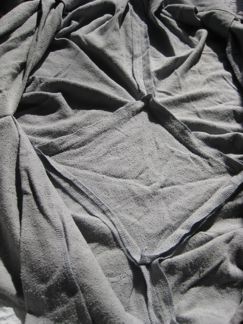
Starting at a side corner of the gusset. Pin the inseam joining the front leg to the back leg from the gusset to the bottom with right sides together. Now stitch that seam. Pin and sew the other inseam joining front leg to back.
Now pin front and back sides together on one leg and stitch from bottom edge to the folded diagonal edge. Do the same for the other leg.
Fold and press the hem. Now you can use sewing machine to do straight stitch hem or a blind stitch hem, or hem by hand.
Mark the middle of the both the inner and outer edge on both body panels. Pin right sides at the inner edge and sew from the middle center to the bottom edge.
Mark a line that is 5.5" wide and and centered at the top of the back seam going out 2.75" from that seam on either side. Now cut along that mark so you have a 5.5" wide slit.
In period, the excess fabric would not be removed, it would be sewn into the neckband. I don't like how bulky that makes the neckband, so I remove the fabric. I mark about 3/8" in from the end of the straight slit and going straight down to the bottom edge and then cut that rectangle of fabric off on both front center edges.
If you have nice clean selvages, you may not need to finish them. However, if the selvage is a different color or is somewhat rough, you should turn selvages under one or twice and press. Then sew them by machine with either straight stitch or blind stitch or by hand with hemming stitch or a slipstitch.
Fold under once or twice and press the hem. Now you can use sewing machine to do straight stitch hem or a blind stitch hem, or hem by hand.
With the right side of fabric facing out fold the neckband in thirds lengthwise, but leave an extra 1/2" sticking out for the seam allowance.
Clip around the neck opening of the body and stay stitch. Measure and mark the seam allowance at the half length point. Unfold the neckband, put right sides together, and pin the seam allowance to the neckband to the inner edge of the body panels. Line up mark for the center of the neckband with the center back seam. You will need to carefully pin at the corners of the neck slit. Now carefully sew the neckband making sure that none of the fabric is caught. In case the neckband is shorter than the body panel, I make sure to start the seam 1/2" in from the neckband end and the stop 1/2" from the other end of the neckbank.
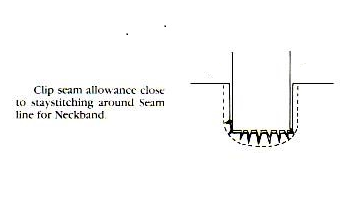
At the neckback fold closest to the neck seam, fold the neckband backwards, but fold the second fold in. Sew both ends of the neckband.
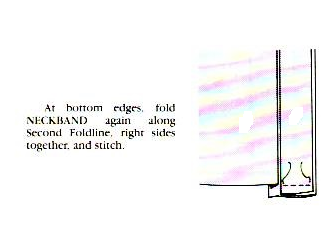
Using slipstitch or hemming stitch, sew the inside of the neckband. You can also sew by machine, but I don't like the way it looks.
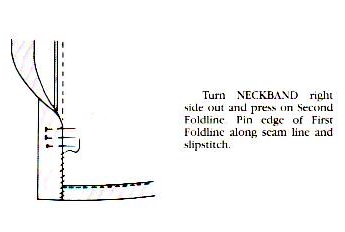
Oribe Tsukime's research and publications for specific construction for Ladies 15th and 16th century kosode style garments.
Sengoku Daimyo website by Anthony J. Bryant and Joshua L. Badgley and specifically the Clothing and Accoessories sections.
The Kosode page on Wodefordhall website. Author Lisa Joseph aka Mistress Saiongi no Hana
My instructions page on my website with various links. Author Hara Kikumatsu.
Major, John S. Textiles, Japanese Encyclopedia of Clothing and Fashion Encyclopedia.com 2020
Yang, Sunny, and Rochelle Narasin. Textile Art of Japan. Tokyo: Shufunotomo, 2000.
Yale University Press. Japan's Golden Age Momoyama. Dallas: Dallas Museum of Art, 1996.
Kure, Mitsuo. Samurai Arms Armor Costume. Edison: Chartwell Books, Inc, 2007.